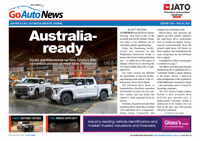 1 Aug 2008
1 Aug 2008
UNIQUE styling, SUV proportions, twin-turbo engines, technology-enhanced sports car handling and ultra-niche positioning formed the hallmarks of the BMW X6 ‘Sports Activity Coupe’.
BMW described it as ‘a blend of the strengths of the BMW X5 and the BMW 6 Series Coupe’.
In fact, the X6 is derived from the second-generation E70 series X5 SUV – itself loosely based on the E60 5 Series – and is similarly built at BMW’s Spartanburg, South Carolina production line.
However, while X6 and X5 shared much of their mechanicals, understructure and interior, they had no body panels in common.
Two well-specified all-wheel drive models were available from launch: a twin-turbo in-line six-cylinder petrol known as the xDrive35i, and the diesel-powered xDrive35d. January 2009 saw the debut of the twin-turbo V8-powered xDrive50i.
With the aid of two turbochargers working on three cylinders each, the xDrive35i produced 225kW of power at 5800rpm and 400Nm of torque at 1300-5000rpm.
Meanwhile, the xDrive35d produced 210kW at 4400rpm and 580Nm from 1750 to 2250rpm.
Both X6 engines were mated to the ZF six-speed automatic transmission common to most contemporary BMWs, recalibrated and retuned for ‘sporty’ response. Steering wheel paddle shifters also made their first appearance in this level of BMW. However no manual gearbox was offered, despite the car’s sporty aspirations.
On the chassis front, the X6 also introduced BMW’s ‘Dynamic Performance Control’ (DPC) rear differential, which, according to the Germans, could push out the dynamic envelope for all-wheel drive vehicles by counteracting the inherent mild understeer for a more RWD-like neutral attitude. This was achieved by switching power between the left and right rear wheels, for improved traction and lateral acceleration, leading to lighter and more precise handling.
The rest of the running gear was pure X5, with double wishbones in the front and BMW’s multi-link arrangement at the rear.
Despite the X6’s plunging roofline, BMW claimed the two rear seats could comfortably accommodate the ‘6-foot 4-inch’ frame of the company's design boss Adrian van Hooydonk.
Luggage space extended from 570 litres to 1450L with the split-fold rear seats in the down position, although four golf bags would fit in the boot area alone.
The twin-turbo petrol V8 xDrive50i flagship finally arrived in early 2009, boasting a 4.4-litre unit with direct petrol injection and a low-inertia turbocharger on each cylinder bank, delivering 300kW of power at 5500rpm and 600Nm of torque from 1750rpm.
That was enough force to sling the 2190kg car from zero to 100km/h in 5.4 seconds.
More potent brakes, featuring 385mm discs grabbed by single-piston aluminium callipers, are fitted, along with self-levelling pneumatic suspension and 20-inch alloy wheels.
The exterior differences between it and other X6 models were subtle, with the main points of difference being chrome window surrounds, a titanium radiator grille surround and dual rectangular chrome exhaust pipes.
Standard features included keyless entry and ignition, head-up information display, four-zone climate control, 16-speaker hi-fi system, steering-wheel-mounted gear shift paddles and anti-dazzle mirrors.
BMW decided to go after the Porsche Cayenne Turbo and Mercedes-Benz ML 63 AMG with the X6 M in late 2009. Under the bonnet was a M GmbH fettled twin-turbo 4.4-litre V8.
Dubbed ‘M TwinPower Turbo’ this EU5 emissions-rated 4395cc unit delivered 408kW of power at 6000rpm and 680Nm of torque from 1500 to 5650rpm.
Aiding this was a production engine world-first common exhaust emission manifold that joined both rows of cylinders to the twin-scroll turbo set-up. Along with the catalytic converters, the turbos were positioned in the V-section between the cylinder rows for faster and more efficient response times. As a result, BMW claimed lag to have been all but eliminated.
This 2305kg SUV’s acceleration from standstill to 100km/h took 4.7 seconds and top speed was limited to 250km/h, while the 14.3 litres per 100 kilometres fuel-consumption average equalled a the 335 grams per kilometre carbon dioxide emissions rating.
The latter was a result of BMW’s EfficientDynamics philosophy – including Brake Energy Regeneration, an on-demand fuel pump, a detachable air-conditioner compressor and a volume flow-controlled supply of the hydraulic fluid for the active anti-roll system.
Electronic dampers were fitted, as well as BMW’s Dynamic Drive technology with self-levelling air suspension out back. Stiffer shockers, modified anti-roll bars and a 10mm ride height drop were also part of the X6 M’s standard specification.
Brakes were 19-inch high-performance items using lightweight technology with ‘virtually’ no fading, according to BMW.
No other BMW M model has had Runflat tyres before, but oddly a spare was also supplied. Tyres were 275/40 R20s in the nose and a set of 315/35 R20s behind.
A diesel entry-level variant of BMW’s coupe-styled X6 SUV landed in Australian showrooms powered by a 3.0-litre, six-cylinder turbo-diesel engine producing 180kW/540Nm and mated with an eight-speed automatic transmission to provide the least expensive X6 with a 0-100km/h time of 7.5 secondsThe xDrive30d also debuted a five-seat option for the previously four-seat only X6 range. The new rear bench retained a 60:40 split-fold function and got a central three-point seatbelt. It also incorporated a centre armrest for outboard occupants to use when the middle place was empty.



































